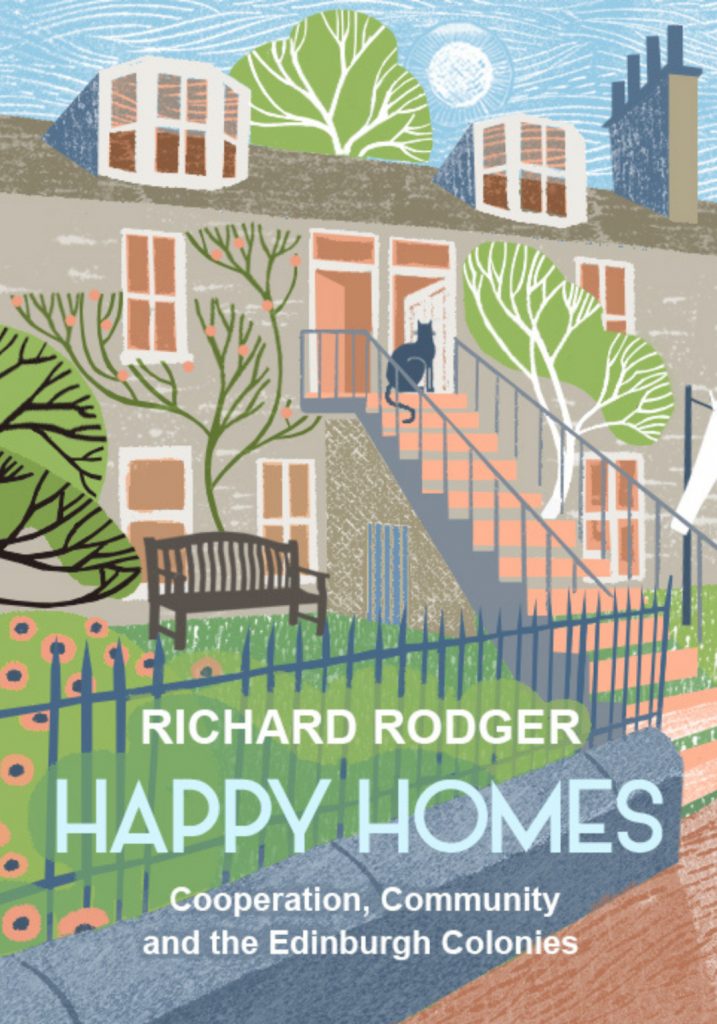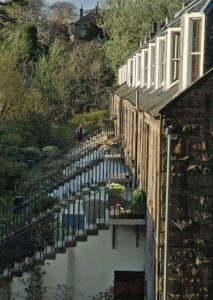Edinburgh’s Colonies – ‘Happy Homes’?

A new book by Professor Richard Rodger – Professor Emeritus of Economic and Social History – looks at the history of one of Edinburgh’s most beloved architectural icons, the ‘Colony’ house.
 My book, “Happy Homes: Cooperation, Community and the Edinburgh ‘Colonies’”, takes its title from the Reverend James Begg’s 1866 publication, “Happy Homes and How to Get Them”. Begg was one of several influential Free Church of Scotland ministers who encouraged better housing as an alternative to what they perceived as the ungodly overcrowded and insanitary tenement flats in the Old Town. Begg made a link between housing improvement and the emergence of environmental biology – as contained in Charles Darwin’s “Origin of the Species” – and with Samuel Smiles’ popular volume “Self Help”, since both of these contemporary bestsellers were concerned in their different ways with the moral and physical improvement of the urban poor.
My book, “Happy Homes: Cooperation, Community and the Edinburgh ‘Colonies’”, takes its title from the Reverend James Begg’s 1866 publication, “Happy Homes and How to Get Them”. Begg was one of several influential Free Church of Scotland ministers who encouraged better housing as an alternative to what they perceived as the ungodly overcrowded and insanitary tenement flats in the Old Town. Begg made a link between housing improvement and the emergence of environmental biology – as contained in Charles Darwin’s “Origin of the Species” – and with Samuel Smiles’ popular volume “Self Help”, since both of these contemporary bestsellers were concerned in their different ways with the moral and physical improvement of the urban poor.
In 1861, in the midst of a long-running strike, the decision by a group of building workers to form and register a Limited Liability Company – one of the earliest in Scotland – and to issue shares, hold meetings, publish accounts, pay dividends, acquire sites and build houses was a truly radical departure. In the first ten years, the Edinburgh Cooperative Building Company (ECBC) obtained and built homes on six different sites, three of them in Leith (Hawthornbank, Ferry Road (Trafalgar Place), Restalrig Park) as well as Stockbridge, Norton Park (Abbeyhill) and Dalry. By 1871, the ECBC had completed over 750 homes and housed 3125 individuals. One in six of all household heads (16.5%) was a woman, over half of whom were widows. As shareholders and property owners women were also entitled to vote, not just in ECBC meetings but also eventually in municipal elections.
By 1914, half a century after its foundation in 1861, the ECBC had built over 2200 properties housing almost 10,000 people on eleven separate ‘Colony’ sites. Was there a bigger builder in Edinburgh between these dates?

Stockbridge Colonies off Glenogle Road
The houses were distinctive in their design – unusually for Scotland these workers’ houses were in terraces – each with a separate front door opening on to a small private garden with a shed or coal store. Entry was from both sides – the upper floor by external staircases on one side of the terrace, and the ground floor flat from the other side of the terrace. There were no through roads giving them a sense of safe, self-contained neighbourhoods each with discrete identities. Internally, there was a range for cooking, WC, sink with cold running water and, depending on the date of construction, one or two bedrooms.
‘New build’ model dwellings for the Edinburgh working classes were a new feature of the 1860s. The names, and indeed the buildings, are still evident in the modern cityscape – Pilrig Buildings, Ashley Buildings, Rosebank Cottages, Chalmers Buildings are just a few identified in “Happy Homes” – but the rents were beyond an unskilled labouring class of workers and, significantly, these model dwellings returned between 5% and 8% on capital invested. Even with ‘Begg’s Buildings’, a block for workers in Brand Place in Abbeyhill, it was not James Begg who invested but Robert Cranston, owner of the Waverley Temperance Hotel on Princes Street, who advanced £6000 for the construction of 72 new homes. His return was 8% – substantially better than government stocks.
“Happy Homes: Cooperation, Community and the Edinburgh ‘Colonies’” is based on a detailed analysis of manuscript census returns, valuation rolls (rental values) and Company records. This reveals much that is new about Edinburgh and the Edinburgh Colonies. The socio-economic composition of residents is explored, ownership patterns are examined, the scale of women’s involvement as household heads and property owners is identified, and the subtle variations in the occupational composition of each of the Colonies is revealed, an analysis of the birthplaces of residents produces intriguing patterns and geographical connections between and within Colonies.

Carvings showing trades involved in building the colonies
Perhaps most surprising is the conclusion that it was commonplace for individuals (rentiers) to buy several properties for letting and so the idea that the Colonies were an early example of a property-owning democracy is misplaced.
There were serious errors of ECBC management. This is not to deny the efforts and competency of James Colville during his 30 years as the ECBC Manager, but the ECBC made some dubious decisions. It was slow to recognise the sharp, sustained downturn in the local (and national) housing market after 1905. It acquired the Baird Saughtonhall estate in 1902 but soon after sold land at Balgreen to other house builders. After the Great War, unlike house builders McTaggart & Mickel, Miller and many others, the ECBC did not contemplate an application for the Treasury subsidies to private housebuilders in the 1920s. The ECBC was in terminal decline and before long the salaries of the office staff exceeded those of the building workers.
While there is rightly a degree of admiration at the ambition and scale of ECBC house building, and their remains a strong degree of local affection amongst the public for Edinburgh and Leith Colony housing in the 21st century, “Happy Homes: Cooperation, Community and the Edinburgh ‘Colonies’” is a hard-nosed assessment rather than a rose-tinted one.
“Happy Homes: Cooperation, Community and the Edinburgh ‘Colonies’” is published by The Word Bank (£15) which is a community initiative of the Old Town Development Trust with support from Scotmid, itself a Cooperative Movement successor to St Cuthbert’s Cooperative Society which was formed just a few months before the ECBC.



